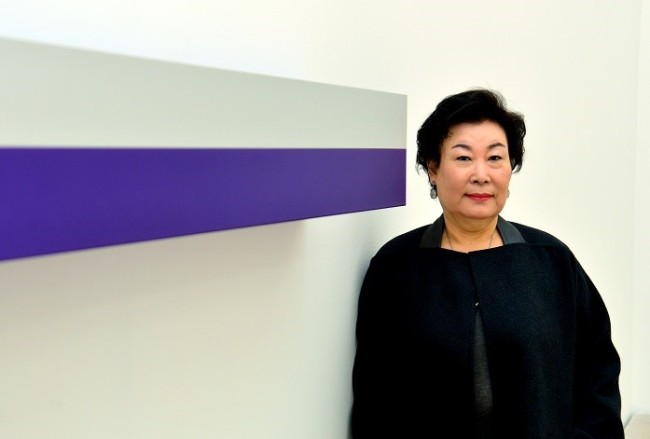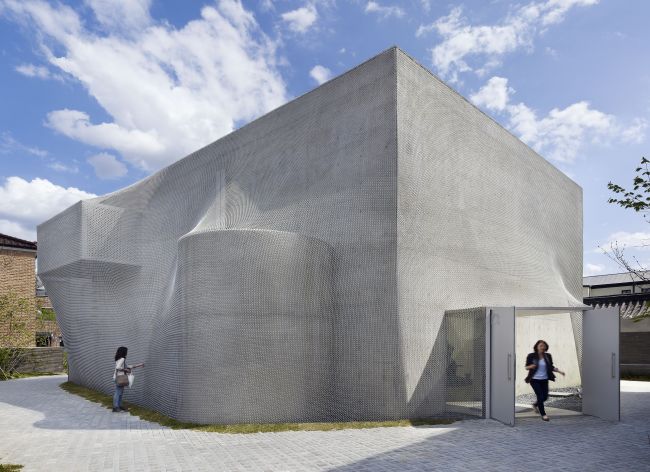On display in the private office of Lee Hyun-sook on the top floor of her gallery in Seoul are items from some of the most significant contemporary exhibitions in Korea over the last couple of years.
The small space overlooking Gyeongbokgung Palace is ultramodern, with a sculpture by Anish Kapoor, a painting by Jean-Michel Basquiat and a glass sculpture by Roni Horn alongside her selection of contemporary designers’ furniture.
Lee’s Kukje Gallery, opened in 1982, has been the first in Korea to showcase work by many prominent foreign artists since the early 1990s. The gallery has introduced works of some of the biggest names in contemporary art, including Louise Bourgeois, Damien Hirst, Anish Kapoor and Alexander Calder.
Her position in the global art world has risen as well. She was listed as a powerful player in the global art scene by the art magazine Art+Auction in 2013. She was cited along with other respected figures, such as Larry Gagosian of Gagosian Gallery, Jay Jopling of White Cube and Emmanuel Perrotin of Perrotin Gallery. She was picked as one of the 100 influential women art dealers by Artnet magazine in 2014.
“What I have done is small compared with those big art dealers, but I think people have recognized my role as an art dealer in Asia,” Lee told The Korea Herald.
 |
Lee Hyun-sook, founder and owner of Kukje Gallery in Seoul, poses for a photo with a Donald Judd sculpture at her gallery. (Yoon Byoung-chan/The Korea Herald) |
A collector of Korean traditional paintings, Lee opened a gallery in Insa-dong, then the hub of major galleries in Seoul, when she was 33. Lee said she had always loved art and wanted to showcase her collection of Korean ink-and-wash paintings and works by modern Korean artists.
Her first exhibition, of a group of modern Korean masters, was a resounding success, with almost every piece sold.
The 1980s was the most vibrant time in the Korean art scene, she said. Work by modern Korean masters fetched almost as much as contemporary foreign artists’ work.
But soon after, she sold most of her personal collection of Korean paintings and began to focus on foreign artists after she visited modern art exhibitions in the U.S. in the late 1980s.
“I was shocked after seeing a mobile by Alexander Calder at an exhibition in the U.S. Minimalism was ending in New York. Koreans were (still) buying and selling impressionistic paintings,” she said.
“The gap between the Korean and foreign art markets was so wide that I used to compare it with the gap between life in South and North Korea. We only traded work that we knew.”
The first foreign artist she introduced to Korea was abstract expressionist Helen Frankenthaler in 1991. Lee saw Frankenthaler’s exhibition at the Museum of Modern Art in New York and decided to exhibit her work at her gallery, which reopened at its current location next to the royal palace.
She visited the gallery that represented the artist and told its owner that she wanted to hold an exhibition of the artist’s work in Seoul.
Intrigued by the idea of exhibiting the artist’s works in an Asian gallery, the owner agreed to let her display them in Seoul.
But Lee’s job required more than bringing the works to Korea. She had to convince the anxious artist, who was afraid of a possible North Korean attack during her exhibition.
After she opened the gate to the foreign art world, she brought big-name modern artists such as Cy Twombly and Louise Bourgeois.
The gallery has lived up to its name, “Kukje,” which means international in Korean. About 60 percent of her clients are foreign collectors and renowned art institutions such as the Museum of Modern Art and Guggenheim Museum in New York and Tate in London. Her gallery has three separate buildings named K1, K2 and K3, along with a sleek Western-style restaurant and wine bar. K3 won a prestigious architectural award.
 |
K3, one of the three gallery buildings of Kukje Gallery, won a New York Design Award from the American Institute of Architects in 2011. (Kukje Gallery) |
Lee has introduced Korean artists overseas, including Kimsooja, Haegue Yang, Gimhongsok and Hong Seung-hye. Some of them have been featured in prestigious art institutions abroad and international biennales.
Recently, she decided to shine the spotlight on the artists of the 1960s and 1970s.
For the last two years, she has worked to create a market for Korean monochrome paintings called “dansaekhwa.” The often overlooked painting movement, formed under the authoritarian governments from the 1960s to 1980s, received eulogies in the global art market when they were first showcased in 2013 at Frieze London.
“All of them were sold,” said Lee with enthusiasm.
The showcase of the dansaekhwa paintings captured the attention of international art circles. People were fascinated by the monochrome style of painting which had emerged outside the mainstream art world of New York and its historical and cultural significance.
Los Angeles-based gallery Blum and Poe focused on a group of dansaekhwa artists at the 2014 Frieze Masters. The gallery is holding a solo exhibition of artist Ha Chong-hyun at the New York branch until Dec. 20. Perrotin Gallery in Paris is presenting a retrospective of dansaekhwa artist Park Seo-bo until Dec. 20.
“Dansaekhwa is everywhere now. It’s not related to K-pop or anything, but it definitely shows that Korea is emerging in the global art scene,” said Lee. “The Korean art market needs several more artists like Kim Whanki and Lee Ufan (whose works are popular on the international market).”
Her yearly schedule is dominated by art fairs in New York, Hong Kong, Basel, Paris and Miami. Although in her mid-’60s, Lee is more enthusiastic than ever.
“My business is in Seoul, but my clients move around the world. I meet them all over the world at major art fairs,” she said. “It’s important that I show up at openings.”
She makes about $20 million worth of art transactions a year abroad.
Lee and owners of other major art galleries in Korea have been monitored by the government to detect money laundering via artwork purchases by family-owned conglomerates. She was investigated by prosecutors at one point over allegations that the Samsung Group’s founding family had raised slush funds.
“Korean collectors are now afraid of even visiting the gallery. It’s important to increase the pool of Korean collectors, but buying artwork at galleries means the money is tracked by the National Tax Service,” she said.
She raised her voice about the negative perceptions of purchasing artwork in Korea.
“If no one buys artwork, it will be difficult to see great paintings like dansaekhwa come out in the future,” she noted. “We can’t expect young artists to grow when we don’t buy their works.”
She expressed regret that art transactions are monitored and supervised as if they’re an illegal activity in Korea.
“It’s a great asset to a country culturally and economically. People don’t realize the important roles of galleries in promoting homegrown artists and their works and making contributions to economic and cultural growth,” she said.
“Korea needs more time to be more mature in art.”
By Lee Woo-young (
wylee@heraldcorp.com)









